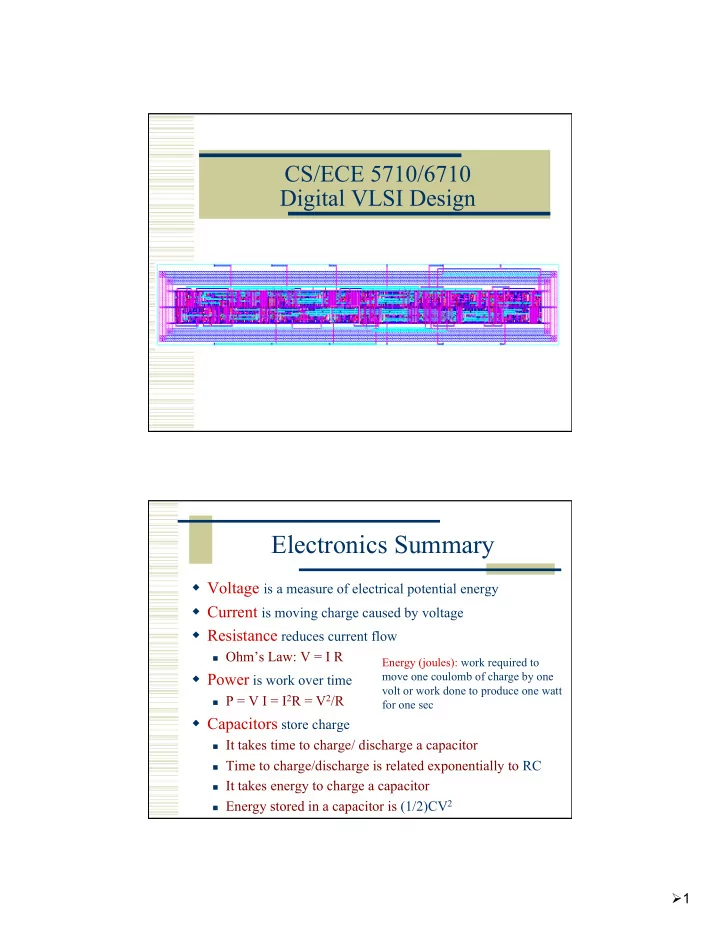

CS/ECE 5710/6710 Digital VLSI Design Electronics Summary Voltage is a measure of electrical potential energy Current is moving charge caused by voltage Resistance reduces current flow Ohm’s Law: V = I R Energy (joules): work required to Power is work over time move one coulomb of charge by one volt or work done to produce one watt P = V I = I 2 R = V 2 /R for one sec Capacitors store charge It takes time to charge/ discharge a capacitor Time to charge/discharge is related exponentially to RC It takes energy to charge a capacitor Energy stored in a capacitor is (1/2)CV 2 1
Reminder: Voltage Division Find the voltage across any series-connected resistors Example of Voltage Division Find the voltage at point A with respect to GND 2
Example of Voltage Division Find the voltage at point A with respect to GND How Does This Relate to VLSI? 3
Model of a CMOS Transistor Two Types of CMOS Transistors 4
CMOS Transistors Complementary Metal Oxide Semiconductor Two types of transistors Built on silicon substrate “majority carrier” devices Field-effect transistors An electric field attracts carriers to form a conducting channel in the silicon… We’ll get much more of this later… For now, just some basic abstractions Silicon Lattice Transistors are built on a silicon substrate Silicon is a Group IV material Forms crystal lattice with bonds to four neighbors Figures from Reid Harrison 5
“Semi” conductor? Thermal energy (atomic-scale vibrations) can shake an electron loose Leaves a “hole” behind Figures from Reid Harrison “Semi” conductor? Room temperature: 1.5x10 10 free electrons per cubic centimeter But, 5x10 22 silicon atoms / cc So, one out of every 3 trillion atoms has a missing e Figures from Reid Harrison 6
Dopants Group V: extra electron (n-type) Phosphorous, Arsenic, Group III: missing electron, (p-type) Usually Boron Figures from Reid Harrison Dopants Note that each type of doped silicon is electrostatically neutral in the large Consists of mobile electrons and holes And fixed charges (dopant atoms) Figures from Reid Harrison 7
p-n Junctions A junction between p-type and n-type semiconductor forms a diode. Current flows only in one direction p-n Junctions Two mechanisms for carrier (hole or electron) motion Drift - requires an electric field Diffusion – requires a concentration gradient Figures from Reid Harrison 8
p-n Junctions With no external voltage diffusion causes a depletion region Causes an electric field because of charge recombination Causes drift current… Figures from Reid Harrison p-n Junctions Eventually reaches equilibrium where diffusion current offsets drift current Figures from Reid Harrison 9
p-n Junctions By applying an external voltage you can modulate the width of the depletion region and cause diffusion or drift to dominate… Figures from Reid Harrison N-type Transistor D + G Vds i electrons S - +Vgs 10
nMOS Operation Body is commonly tied to ground (0 V) When the gate is at a low voltage: P-type body is at low voltage Source-body and drain-body diodes are OFF No current flows, transistor is OFF nMOS Operation Cont. When the gate is at a high voltage: Positive charge on gate of MOS capacitor Negative charge attracted to body Inverts a channel under gate to n-type Now current can flow through n-type silicon from source through channel to drain, transistor is ON 11
P-type Transistor S + -Vgs G Vsd i holes - D pMOS Transistor Similar, but doping and voltages reversed Body tied to high voltage (V DD ) Gate low: transistor ON Gate high: transistor OFF Bubble indicates inverted behavior 12
A Cutaway View CMOS structure with both transistor types Transistors as Switches For now, we’ll abstract away most analog details… D Good 0 Good 1 G G=0 G=1 S Poor 1 Good 0 S Good 0 Good 1 G G=0 G=1 D Poor 0 Good 1 Not Perfect Switches! 13
“Switching Circuit” For example, a switch can control when a light comes on or off +5v No electricity can flow 0v “AND” Circuit Both switch X AND switch Y need to be closed for the light to light up +5v X Y 0v 14
“OR” Circuit The light comes on if either X OR Y are closed +5v X Y 0v CMOS Inverter 15
CMOS Inverter A Y 0 1 CMOS Inverter A Y 0 1 ? 16
CMOS Inverter A Y 0 1 0 CMOS Inverter A Y 0 1 1 0 17
Timing Issues in CMOS Power Consumption 18
CMOS NAND Gate CMOS NAND Gate A B Y 0 0 0 1 1 0 1 1 19
CMOS NAND Gate A B Y 0 0 1 0 1 1 0 1 1 CMOS NAND Gate A B Y 0 0 1 0 1 1 1 0 1 1 20
CMOS NAND Gate A B Y 0 0 1 0 1 1 1 0 1 1 1 CMOS NAND Gate A B Y 0 0 1 0 1 1 1 0 1 1 1 0 21
CMOS NOR Gate 3-input NAND Gate Y pulls low if ALL inputs are 1 Y pulls high if ANY input is 0 Take a moment and draw what you think the transistor circuit for a 3-input NAND gate should be… 22
3-input NAND Gate Y pulls low if ALL inputs are 1 Y pulls high if ANY input is 0 Static CMOS Gate Template P-Type pullups and N- Vdd Type pulldowns Pullup Boolean duals of each Inputs Network other… (PUN) Note the natural Output inverting behavior… N-types turn on with high voltages, but pull low Pulldown P-types turn on with low Network voltages, but pull high (PDN) GND 23
N-type and P-type Uses Because of the imperfect nature of the the transistor switches ALWAYS use N-type to pull low ALWAYS use P-type to pull high If you need to pull both ways, use them both In S=0, In = Out S S S=1, In = Out Out Switch to Chalkboard Complex Gate Tri-State Latch D-register XOR 24
Recommend
More recommend